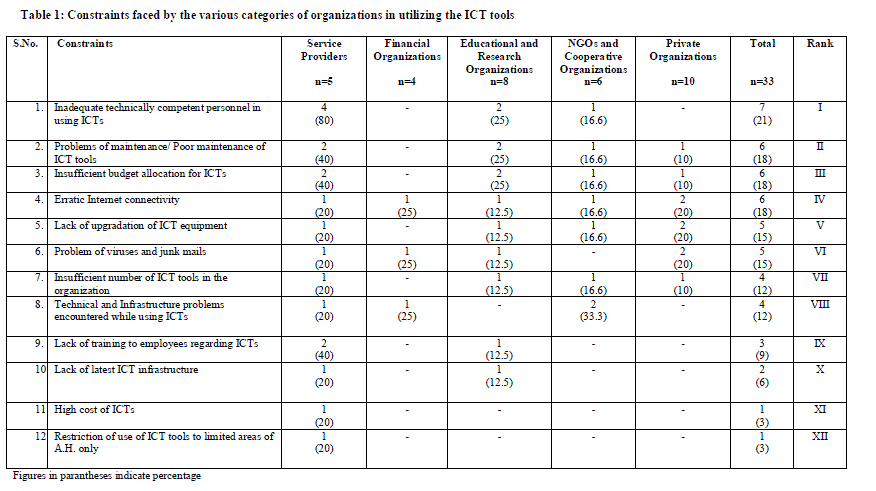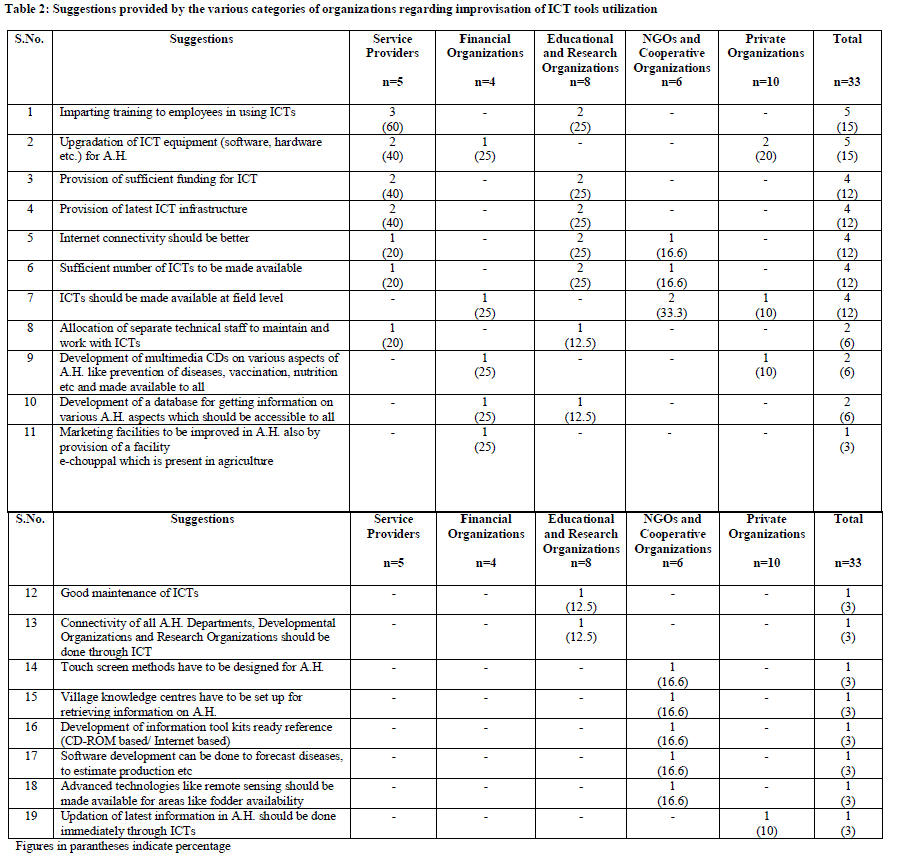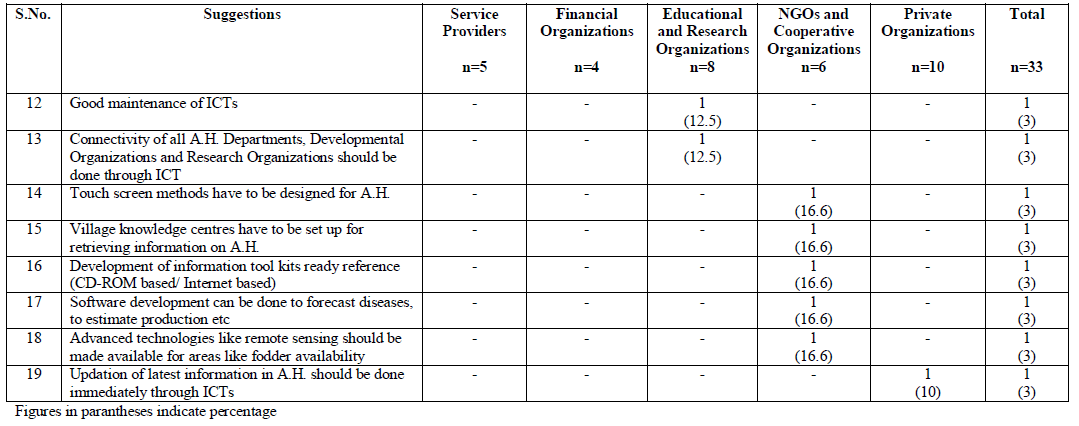ISSN ONLINE(2319-8753)PRINT(2347-6710)
ISSN ONLINE(2319-8753)PRINT(2347-6710)
Dr. P.Sireesha1, Dr.B.Sudhakar Rao2 and Dr.D.Thammi Raju3
|
| Related article at Pubmed, Scholar Google |
Visit for more related articles at International Journal of Innovative Research in Science, Engineering and Technology
Data was collected from 33 organizations which were actively involved in Animal Husbandry activities and elicited through a questionnaire following an exploratory research design on “Utilization of Information and Communication Technology (ICT) tools by various organizations in Animal Husbandry – A study in Andhra Pradesh.” The major constraints faced in the use of ICT tools were inadequate technically competent personnel in using the ICTs, problems of maintenance of ICT tools, interruptions in Internet connectivity, insufficient budget allocation for ICT tools, lack of upgradation of ICT equipment and problem of viruses and junk mails. Some of the major suggestions provided by the users regarding the improvisation of ICT tools utilization were imparting training to employees regarding the use of ICT tools, upgradation of equipment, provision of sufficient funding for ICT, provision of latest infrastructure, provision of better Internet connectivity, availability of sufficient number of ICT tools and ICT tools to be made available at field level
Keywords |
| ICT, Animal Husbandry organizations, constraints of ICT. |
INTRODUCTION |
| Livestock sector is one of the allied sectors which has proved to be an integral part of livelihood system of rural families and continues to be a major source of rural economy. There is rapid growth in the overall livestock production of our country which can be attributed to the technological revolution in A.H. and the successful adoption of recommended technologies by the rural farmers through different channels of information dissemination by the extension agencies. Apart from the conventional methods of information dissemination like traditional extension methods, electronic and print media, the recent foray into information gateway is the initiative of ICT tools in Agriculture and allied sectors. |
| In order to transform livestock sector into information driven, modern and competitive sector, the role of Information and Communication Technology (ICT) cannot be overruled. They provide faster and newer ways of delivering and accessing information. The people working in the livestock sector are least equipped with proper tools to deal with rapidly changing livestock production scenario and international competitive environment. At present, the ratio of the farmers to the extension workers is 1000:1(Kumar, 2005), also the existing transfer of technology mechanisms and extension programmes run by the government departments are slow and in many cases ineffective in view of the vast gaps between the research and farmers linkages. This is partly due to inadequate use of new areas of information dissemination in various development programmes. The introduction of ICT helps in upgrading the information at least cost. |
| Information technology has demonstrated its utility and advantages in all elements of human life and especially in vocations of agriculture and allied sectors enhancing the productivity either directly or indirectly. The existing “technology divide” can be addressed effectively through the use of ICT, especially when the present system is no longer relevant and able to meet the increasing demands of our farming community. In a fast changing global environment, livestock production has to be more dynamic so as to harness the latest technologies and emerging opportunities due to globalization. |
| Without communication capabilities, access to information, analyze and share the information in the livestock sector remains at the mercy of global market forces. At this juncture, a rural friendly ICT policy that recognizes the Government’s fibre network as a national asset and offers concession to those who extend the network to rural India will certainly prove to be a big boost to the rural GDP in the coming years. Complementing the new ICT revolution, it is important for the Government to recognize the need for the establishment of Community Information centers at both village and block level that have the potential to reach out to rural communities, which will extend the Government’s audiovisual and publicity efforts on various entitlements and programmes and information on technical, socio-economic and health related issues, while empowering the rural community to communicate and develop structure for a knowledge intensive rural production system. |
OBJECTIVES OF THE STUDY |
| 1. To bring about the constraints/problems faced by them in utilizing the ICT tools and also ascertain the suggestions for the same. |
METHODOLOGY |
| The study was purposively conducted in Hyderabad and Rangareddy districts of Andhra Pradesh as most of the Animal Husbandry organizations are located in these two districts. A total of 33 organizations which are actively involved in Animal Husbandry activities were selected for the purpose of study. Several organizations involved in the livestock development either directly or indirectly in Andhra Pradesh were ascertained in consultation with various sources viz. consultation with experts, secondary sources such as reports, literature, documents etc. The questionnaire for the organizations was developed in consultation with experts in the field of Animal Husbandry extension and those involved in computer applications. Rapport with the representatives of organizations is very essential so as to get accurate responses. In the present study the investigator established initial rapport with the organizations selected for the study and got acquainted with the officials personally. Later after the development of the questionnaire the investigator handed over the questionnaire to the concerned officials of the selected organizations and elicited their responses through the questionnaire. Questionnaire was prepared in English and data was collected from 33 organizations. It was made sure that all the questions in the questionnaire were self explanatory. Statistical tools used for analysis of data included frequency and percentages. |
RESULTS AND DISCUSSION |
| A total of 33 organizations which are actively involved in Animal Husbandry activities were selected for the purpose of study. Based on the nature of work, functions, type of administration, the organizations considered for the study were grouped into five categories for better presentation of the results and subsequent discussion. They are: |
| 1. Service Providers |
| 2. Financial Organizations |
| 3. Educational and Research Organizations |
| 4. Non Governmental Organizations and Cooperative Organizations |
| 5. Private Organizations |
| The different organizations were categorized into the above five categories are detailed below. |
I. Service Providers: |
| 1. State Animal Husbandry Department |
| 2. Commissionerate of Rural Development -Rural Livelihood project |
| 3. Andhra Pradesh Livestock Development Agency (APLDA) |
| 4. Andhra Pradesh Meat Development Corporation (APMDC) |
| 5. State Management Institute for Livestock Development in Andhra Pradesh (SMILDA) |
II. Financial Organizations: |
| 1. National Bank for Agriculture and Rural Development (NABARD) |
| 2. Andhra Pradesh Cooperative Bank (APCOB) |
| 3. State Bank of India - Agri business unit (SBI) |
| 4. Bharatiya Samruddhi Investments and Consulting Services Limited (BASIX) |
III. Educational and Research Organizations: |
| 1. National Institute of Rural Development (NIRD) |
| 2. National Academy of Agricultural Research Management (NAARM) |
| 3. Project Directorate on Poultry (PDP) |
| 4. Central Research Institute for Dryland Agriculture (CRIDA) |
| 5. National Research Centre on Meat (NRC ON Meat) |
| 6. Sri Venkateswara Veterinary University -College of Veterinary Science, Hyderabad (SVVU) |
| 7. Veterinary Biologicals Research Institute (VBRI) |
| 8. Indian Immunologicals |
IV. Non Governmental Organizations and Cooperative Organizations: |
| 1. JK Trust Gram Vikas Yojana |
| 2. ANTHRA |
| 3. Watershed Support Services and Activities Network (WASSAN) |
| 4. InterCooperation Social Development |
| 5. Andhra Pradesh Dairy Development Cooperative Federation (APDDCF) |
| 6. National Egg Coordination Committee (NECC) |
V. Private Organizations: |
| 1. Venkateswara Hatcheries |
| 2. Suguna Poultry |
| 3. IndBro Research and Breeding farms |
| 4. Poshak Feeds Private Limited |
| 5. Vimala feeds Private Limited |
| 6. Miracle Feeds Private Limited |
| 7. Intas Pharmaceuticals Limited |
| 8. Neospark drugs and chemicals Limited |
| 9. Sarabhai Zydus Animal Health Limited |
| 10. Natural Remedies Private Limited |
Constraints faced by various categories of organizations in utilizing the ICT tools |
| Table 1 points that the major constraint was lack of technically competent personnel in using ICT tools as expressed by 80% of Service Providers, 25% of Educational and Research Organizations and 16.6% of NGOs and Cooperative Organizations. This may be because of lack of human resources well versed in using ICT tools for the organizations and limited resources. |
| The problems of insufficient budget allocation for ICT tools and problems of maintenance or poor maintenance of ICT tools (Adam and Wood 1999) were expressed by 40% of Service Providers, 25% of Educational and Research Organizations, 16.6% of NGOs and Cooperative Organizations and 10% of Private Organizations. The problem of insufficiency of budget has been encountered by them may be because the Government has not still recognized the importance of ICT in A.H. This trend also might be attributed to the reason that the importance of ICT has not been recognized by policy makers or they might have felt some more important areas to be given thrust for finance other than ICTs. The problem of poor maintenance of ICT tools may be due to lack of human resources for proper maintenance of ICTs and insufficiency of financial resources for the repairing and maintenance of ICT tools. |
| 40% of Service Providers and Private Organizations, 12.5% of Educational and Research Organizations, 16.6% of NGOs and Cooperative Organizations reported the problem of erratic Internet connectivity and this might be because of poor service by service providers of Internet and lower bandwidth. |
| The problem of lack of upgradation of ICT equipment was expressed by 20% of Service Providers and Private Organizations, 12.5% of Educational and Research Organizations, 16.6% of NGOs and Cooperative Organizations and this may be because the personnel are not trained or exposed on the usage of different equipment or the personnel may not be aware of the recent updates. 25% of Financial Organizations, 20% of Service Providers and Private Organizations and 12.5% of Educational and Research Organizations reported to have faced the problem of viruses and junk mails might be because of non provision of regular updation of antivirus and provision of filters. |
| 20% of Service Providers, 12.5% of Educational and Research Organizations, 16.6% of NGOs and Cooperative Organizations and 10% of Private Organizations reported the problem of insufficient number of ICT tools in the organization which may be due to inadequate budget allotted for it. The problem of facing of technical and infrastructure problems while using ICTs was expressed by 33.3% of NGOs and Cooperative Organizations, 25% of Financial Organizations, 20% of Service Providers (Adam 2005 and Sharma and Arya, 2005). Technical constraint might be because of lack of human resources skilled in the usage of ICTs and infrastructure constraint might be because of non provision of infrastructure needed or supporting infrastructure for example the need for UPS during power failures for the computers. |
| The problem of lack of training to employees for using ICTs was expressed by 40% of Service Providers and 12.5% of Educational and Research Organizations (Gelb and Parker, 2004 and Rathore and Singh, 2006) and this could not be provided because of lack of time and also insufficient budget. 20% of Service Providers and 12.5% of Educational and Research Organizations reported to have faced the problem of lack of latest ICT infrastructure and this is due to insufficient funding for ICT. The problems of high cost of ICTs and restriction of use of ICT tools to limited areas of A.H. were encountered by 20% of Service Providers. |
 |
Suggestions provided by the various categories of organizations regarding improvisation of ICT tools utilization |
| It could be observed from Table 2 that 60% of Service Providers and 25% of Educational and Research Organizations felt the need of imparting training to employees in using ICTs (Aneeja and Shenoy 2004). This might be because they felt that the constraint is due to lack of training to its employees in the use of ICTs. Upgradation of ICT equipment (software, hardware etc.) for A.H. was suggested by 40% of Service Providers, 25% of Financial Organizations and 20% of Private Organizations and this could be because they might have faced problems with outdated equipment. |
| Provision of sufficient funding for ICT and latest ICT infrastructure were suggested by 40% of Service Providers and 25% of Educational and Research Organizations as they faced constraints like insufficient budget. 25% of Educational and Research Organizations, 20% of Service Providers and 16.6% of NGOs and Cooperative Organizations felt the need of better Internet connectivity and availability of sufficient number of ICT tools in the organization because they would have faced the problem of insufficiency of ICT tools. The need for better Internet connectivity (Deveraj and Chaturvedi 2003) could be because of poor service by Internet service providers. |
| 33.3% of NGOs and Cooperative Organizations, 25% of Financial Organizations and 10% of Private Organizations felt that ICT tools should be made available at field level as they might have felt that they could improve their performance if provided with ICT tools. 20% of Service Providers and 12.5% of Educational and Research Organizations suggested the need of allocation of separate technical staff to maintain and work with ICTs as they felt the constraint of inadequate technically competent personnel skilled in the usage of ICTs. |
| Development of multimedia CDs on various aspects of A.H. like prevention of diseases, vaccination, nutrition etc and their availability to all was suggested by 25% of Financial Organizations and 10% of Private Organizations as the number of Multimedia CDs available regarding A.H. is less. 25% of Financial Organizations and 12.5% of educational and Research Organizations felt that a database should be developed for getting information on various A.H. aspects which should be accessible to all and this might be because there is no database available and accessible which covers all aspects of A.H. |
| 25% of Financial Organizations felt that marketing facilities needs to be improved in A.H. also by provision of a facility like e-chouppal which is present in agriculture as there is no proper organized marketing facility available for A.H and this could be achieved by public private partnerships. The suggestions of good maintenance of ICTs and connectivity of all A.H. Departments, Developmental Organizations and Research Organizations should be done through ICT were given by 12.5% of Educational and Research Organizations. Connectivity between the organizations helps in coordination between the organizations for exchange of latest information, results of research which in turn can be transferred to the ground level (Cebeci and Aykut, 2003, Oryokot 2003 and Frempong 2006). |
| 16.6% of NGOs and Cooperative Organizations suggested that touch screen methods have to be designed for A.H., village knowledge centres have to be set up for retrieving information on A.H., development of information tool kits ready reference, software development can be done to forecast diseases, to estimate production etc and advanced technologies like remote sensing should be made available for areas like fodder availability by which the livestock farmers can be benefited. 10% of the Private Organizations felt that there is a need for updation of latest information in A.H. immediately through ICTs as the traditional extension system suffers from certain drawbacks such as expensive in nature, irrelevancy of the content, inadequate coverage, one way information system, erosion of messages in passing through different layers, extension personnel’s ineffective communication and ICT can help to overcome the barriers of traditional extension system to a greater extent (Sasidhar and Sharma 2006). |
 |
 |
References |
|